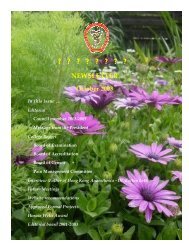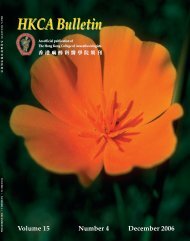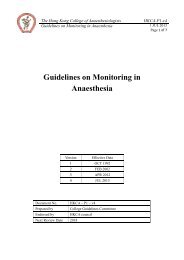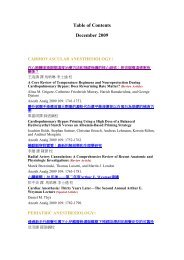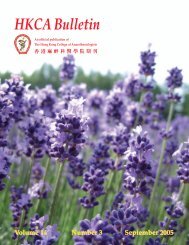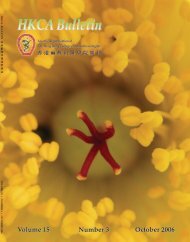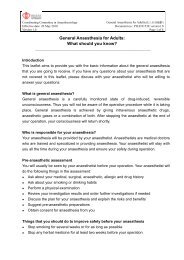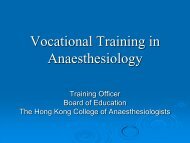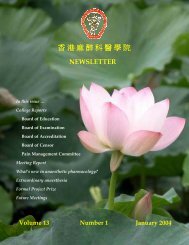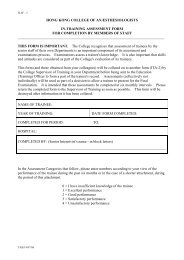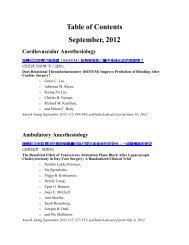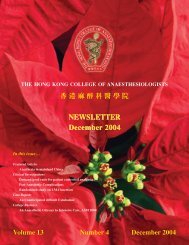July 2005 - The Hong Kong College of Anaesthesiologists
July 2005 - The Hong Kong College of Anaesthesiologists
July 2005 - The Hong Kong College of Anaesthesiologists
You also want an ePaper? Increase the reach of your titles
YUMPU automatically turns print PDFs into web optimized ePapers that Google loves.
Perioperative NursingBull HK Coll Anaesthesiol Volume 14, Number 2 <strong>July</strong> <strong>2005</strong>An audit <strong>of</strong> Perioperative Hypothermia in the Elderly Patients1Man Shan Ma, 2 Alick HF ChiuDepartment <strong>of</strong> Anaesthesiology, Operating <strong>The</strong>atre and Sterile Supply, North District Hospital, <strong>Hong</strong> <strong>Kong</strong>SUMMARYWe conducted an audit <strong>of</strong> temperature management in the perioperative period. Core temperature wasrecorded in the elderly patients using a tympanic thermometer during reception to the theater suite, 1and 3 hours after <strong>of</strong> surgery and upon admission to and discharge from the recovery room. We foundthat the use <strong>of</strong> force air warming device with hospital blanket reduce the incidence <strong>of</strong> hypothermia from7% to less than 1%. <strong>The</strong>re was no evidence <strong>of</strong> thermal injury. We concluded that force air warming withhospital blanket is an effective, efficient way to maintain perioperative normothermia.Keywords: Geriatric; anesthesia, hypothermia, perioperative phase, force air warmingBull HK Coll Anaesthesiol <strong>2005</strong>;14:90‐4Hypothermia is defined as coretemperature less than 36°C. 1‐6Inadvertent hypothermia is associatedwith a number <strong>of</strong> serious consequences. 6‐8Patient experienced hypothermia have increasedincidence <strong>of</strong> wound bleeding and infection,decreased cardiac function, delayed recoveryfrom anesthesia and a longer stay in theoperating room. 7,8 In March, 2000, we found that7% <strong>of</strong> all patients undergoing elective surgeryhad hypothermia during their stay in theoperating room. In this survey, we noted thatelderly patient are especially vulnerable becausethey have less subcutaneous fat, decreasedmetabolic rate and impaired cold sensation.In the literature, a number <strong>of</strong> interventionsare shown to be effective in preventinghypothermia. Warmed intravenous fluid, cottonblanket and heated airway humidification weretechniques that are commonly applied in ourhospital. 9‐15 In this audit, we evaluated the use <strong>of</strong>forced air warming to prevent perioperativehypothermia in elderly patients scheduled forgeneral surgical procedures. <strong>The</strong> objective <strong>of</strong> theprogram was to limit the occurrence <strong>of</strong>perioperative hypothermia to less than 7%among our target group <strong>of</strong> patients.Methods and Materials1RN, BN, Registered Nurse; 2RN, DepartmentOperation Manager. Department <strong>of</strong> Anaesthesiology,Operating <strong>The</strong>atre and Sterile Supply, North DistrictHospital, <strong>Hong</strong> <strong>Kong</strong>Address correspondence to: MS Ma, DepartmentAnaesthesiology, Operating <strong>The</strong>atre and SterileSupply, North District Hospital, 9 Po Kin Road,Sheung Shui, NT. E‐mail: mams323@yahoo.com.hk<strong>The</strong> study was performed in the operatingtheatre <strong>of</strong> the North District Hospital. <strong>The</strong>perioperative nursing team got together andformulated an action plan.Target patient group selection<strong>The</strong> team recognized patients more than 60years, <strong>of</strong> either gender, undergoing elective90



